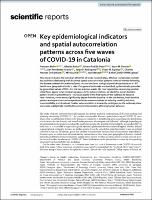Key epidemiological indicators and spatial autocorrelation patterns across five waves of COVID-19 in Catalonia

Author
Date
2023-06-15Permanent link
https://hdl.handle.net/11351/9878DOI
10.1038/s41598-023-36169-2
ISSN
2045-2322
PMID
37322048
Abstract
This research studies the evolution of COVID-19 crude incident rates, effective reproduction number R(t) and their relationship with incidence spatial autocorrelation patterns in the 19 months following the disease outbreak in Catalonia (Spain). A cross-sectional ecological panel design based on n = 371 health-care geographical units is used. Five general outbreaks are described, systematically preceded by generalized values of R(t) > 1 in the two previous weeks. No clear regularities concerning possible initial focus appear when comparing waves. As for autocorrelation, we identify a wave’s baseline pattern in which global Moran’s I increases rapidly in the first weeks of the outbreak to descend later. However, some waves significantly depart from the baseline. In the simulations, both baseline pattern and departures can be reproduced when measures aimed at reducing mobility and virus transmissibility are introduced. Spatial autocorrelation is inherently contingent on the outbreak phase and is also substantially modified by external interventions affecting human behavior.
Keywords
Epidemiology; StatisticsBibliographic citation
Belvis F, Aleta A, Padilla-Pozo Á, Pericàs J-M, Fernández-Gracia J, Rodríguez JP, et al. Key epidemiological indicators and spatial autocorrelation patterns across five waves of COVID-19 in Catalonia. Sci Rep. 2023 Jun 15;13:9709.
Audience
Professionals
This item appears in following collections
- Col·lecció especial COVID-19 [945]
- HVH - Articles científics [4476]
- VHIR - Articles científics [1751]
The following license files are associated with this item:

 Private area
Private area Contact Us
Contact Us







